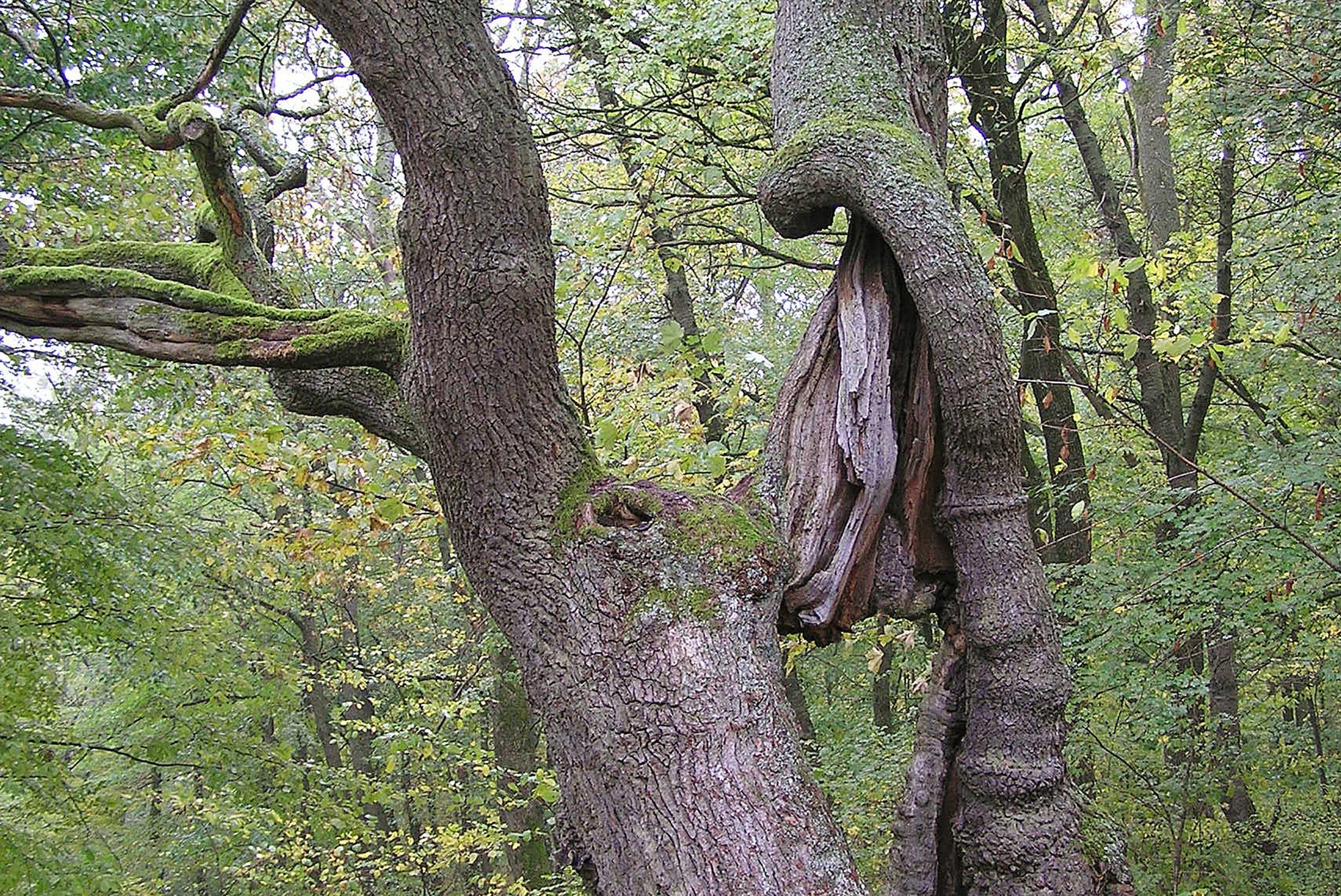Dead trees, standing or fallen or parts of them (e.g. trunks) or individual dead branches on old trees can all be called deadwood. Belonging to the group of saproxylic insects are not only species which live directly off bark or wood, but all species which at some time or other in their lives depend on deadwood. These are, apart from the actual wood eaters (xylophages), insects, which as second phase colonisers use the holes and tunnels for their own broods, without actually living off the wood substrate.
Belonging to this group are for example, various species of wild bees or wasps or various fly and midge maggots which graze off the fungi and bacteria growing in the drilled out tunnels or feed off dead material and excrement. Tree sponges growing on deadwood shelter specialized beetles and flies. Many predatory and parasitic insects such as predatory beetles or parasitic ichneumon depend on these wood dwellers. Various typical saproxylic groups of insects are portrayed below.
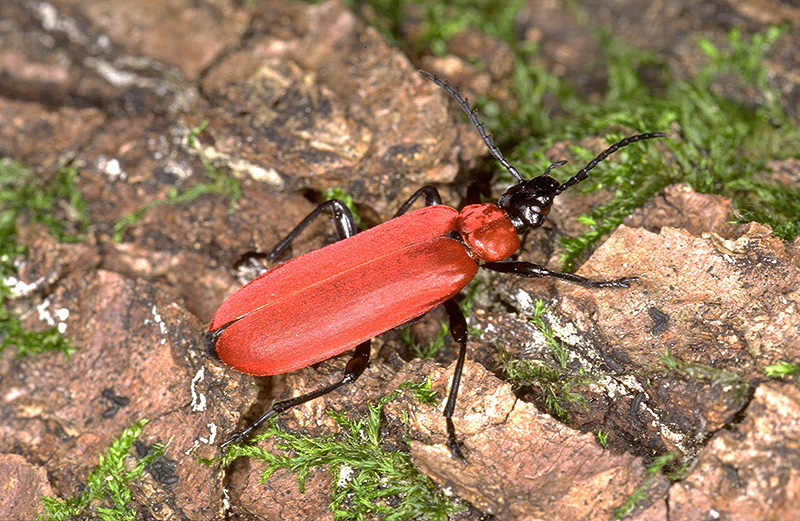
Fig. 1 - The larvae of the bright red cardinal beetle live as predators under the bark. Photo: Beat Wermelinger (WSL)
Beetles
Beetles are not just the most numerous species within the group of insects, but are also the most diversified in deadwood. In central Europe 1340 species are, at some time in their phase of development, dependant on old or dead wood. The over 110 species of bark beetles in Switzerland mainly colonise trees which are already dead. Belonging to the pioneer species of insects which start the wood decomposing, they eat away at the bark and drill holes into it. Unlike the tiny bark beetles which are only millimetres in size, the much larger longhorn beetles and jewel beetles are easier to spot. Their larvae eat into the bark and the wood. Many species of these beetles can often be observed on freshly dead trees or on wood in lumber yards.
The spruce longhorn beetles (Tetropium) or the large musk beetles on coniferous wood for example. The Callidium beetles (Callidium, Phymatodes) prefer coniferous wood which is already dry. These sometimes hatch in firewood which has been stored inside. Jewel beetles are glittering treasures. The worm like tunnels with razor sharp cut edges which can sometimes be seen along wooden fences are the work of their larvae. They are also to be found regularly in lumber yards.
Typical hard wood colonisers are: the antelope or wasp beetles (Chlorophus,Clytus, Xyotrechus) which have similar markings to wasps; opalescent musk beetles (Aromia moschata) and linden burn cow beetles (Scintillatrix rutilans). The smaller longhorn beetles (Anastrangalia, Corymbia, Leptura, Stenurella) often sit on colourful flowers where they feed off the pollen necessary for pubescence. After a two year stage of development the two banded longhorn beetles (Rhagium) pupate in the typical oval "cradles" of wood shavings found under the bark of conifer or deciduous trees. On loosening old bark these wood shaving cradles are, for a long time afterwards, testimony to their makers.
An especially lovely, but very rare longhorn beetle, the alpine longhorn beetle (Rosalia alpina) develops in old splintered beech trunks. This beetle is protected in the whole of Europe and in countries where it still is to be found it is considered to be on the verge of extinction. One of the largest populations of the alpine longhorn beetle in Switzerland is to be found in the lower Prattigau. Isolated beetles have been found around the area of the Walensee. There have been old findings on the Buchberg along the lake of Zurich.
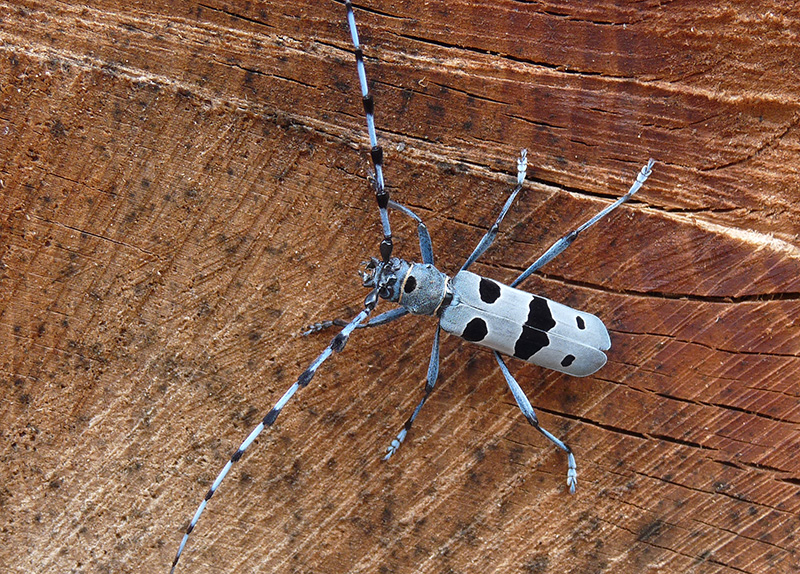
Fig. 2 - The alpine longhorn beetle prefers to lay its eggs in freshly dead beech wood. Photo: Thomas Reich (WSL)
Whether the alpine longhorn beetle also exists in beech stands on the sunny slopes in the Werdenberg area is not known. It would surely be worth while, in July or August, searching for this beetle in woodpiles which have been stacked in sunny locations. This firewood is the main reason for the endangerment of the alpine beetle. The females lay their eggs in the firewood logs and because the larvae take 3 years to develop they mainly end up in a wood stove or fireplace before the adult beetles can hatch. Rosalia has already been pictured on stamps in 7 European countries and is a long running subject on stamps in Switzerland. Of the other beetle families the stag beetle, which is also very rare and protected, deserves a special mention. Its larvae feed off the mulm of old oak trees for up to 5 years.
Apart from the actual xylophagous beetles, there are also predator beetle species such as the cardinal beetles whose larvae feed off various beetle larvae under the bark, or the chequered beetles whose larvae feed off bark beetles. A whole group of beetles, the sponge eaters, have become specialized in colonising tree sponges.
Hymenoptera
Even Hymenoptera with their fragile wings develop in wood. There are also various wild bees which lay their broods in deadwood. Various leaf cutter bees (Megachile) or the endangered wood bees (Xylocopa) use old beetle tunnels for their broods or gnaw out new ones themselves. The tunnels are then divided into separate cells in which a bee larva develops feeding off stored pollen and nectar.
The digger wasps, mud dauber wasps and spider wasps also use the empty spaces in a similar way. They bring in prey as food for their larvae. The prey is not dead but paralysed. The wasp larvae therefore feed off living but defenceless prey. The wasp larvae can themselves become the prey of the next level of parasitic wasps, for example, the iridescent ruby tailed wasp (Chrysis ignata). And these are then targets of the parasitic chalcidoid wasps. Finally hornets and various fold wasps like to build their nests in cavities in old trees.
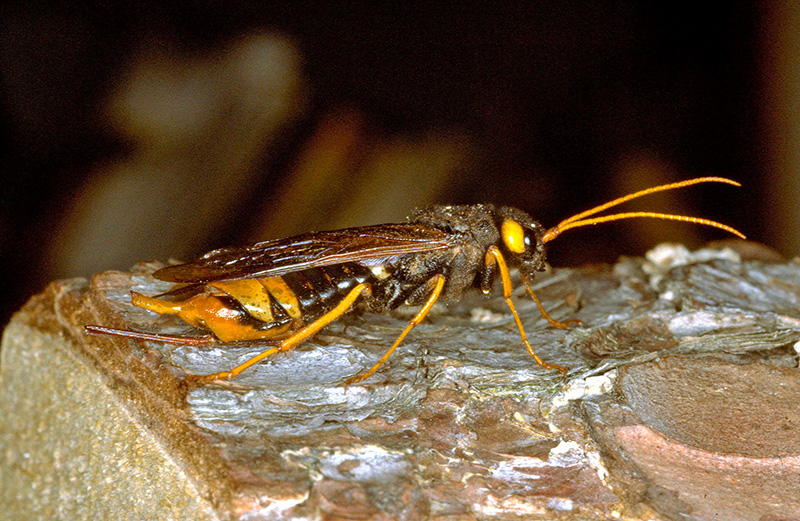
Fig. 3 - The giant wood wasp (Urocerus gigas) at 4 cm in length is Europe’s largest hymenopteran. Photo: Beat Wermelinger (WSL)
The wood wasp is to be found on freshly cut soft wood especially in mountain forests. The horntail, which has become rare in central areas, is at 4 cm in length Europe’s largest hymenopteron. It does not sting in spite of its wasp like colouring and its powerful boring ovipositor. The female lays her eggs in the wood with the ovipositor and inoculates them with fungal spores. These germinate inside the wood and break down lignin and cellulose. The horntail larvae feed off these carpets of fungi. At the end of their three year development the fully grown wasps gnaw their way to freedom. Wood wasps have a specialised natural enemy: the large ichneumon wasp (Rhyssa persuasoria). Just as imposing in size and colouring it locates the horntail larvae within the wood and with its ovipositor implants them with an egg.
The large ant hills of the protected red wood ants of the genus Formica are well known. In order to establish such a nest the queen ant looks for a colony of Serviformica ants, whose queen is then killed by the Formica queen. The motherless Serviformica worker ants then bring up the descendents of the Formica queen, who eventually take over the function of the Serviformica ants. The larger carpenter ants (Camponotus) often nest in dead soft or hard wood and totally eat away the inside. The jet black ant (Lasius fuliginosus) builds its cardboard nests in hollow tree trunks.
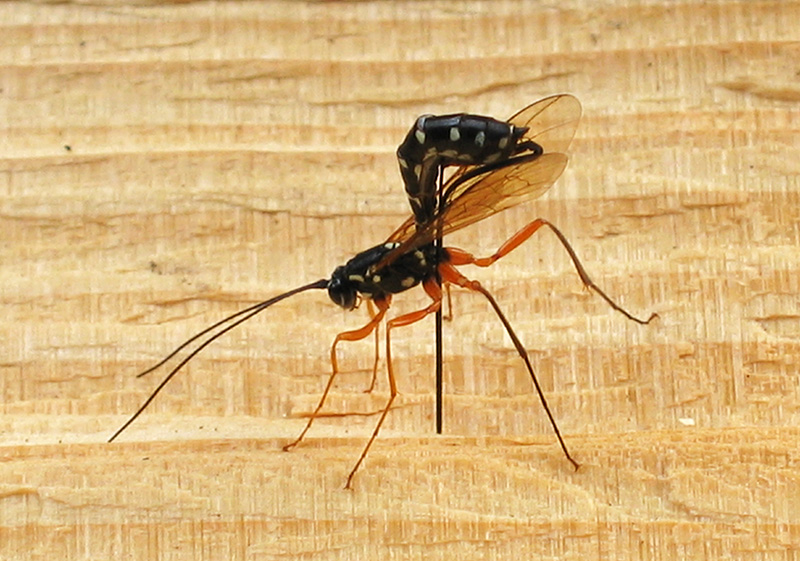
Fig. 4 - A giant Icheumon wasp (Rhyssa persuasoria) laying eggs in fresh coniferous wood. Photo: Thomas Reich (WSL)
Other insects
Apart from beetles and Hymenoptera there are several other groups of insects which develop in fresh or decomposing wood. The larvae of certain crane flies or hover flies, which can be recognised as adults by their wasp like colouring and helicopter like hovering, feed off mulm and excrements of other insects. Flies and mosquitoes make up about a half of all insects living in wood. Even today, in Switzerland, new species which are unknown to science are occasionally discovered amongst these groups. Of great importance for soil fertility are the tiny springtails (Collembola). Often occurring in forest soil in numbers of approximately 10’000 per square metre they reduce the decayed wood to humus. In the mountains the humus can consist purely of collembolan excrement.
Other animals also profit from deadwood
Other vertebrates also use the substrate deadwood. Woodpeckers mainly eat insects living in the wood and use their strong beaks to hollow out their nests in old and dead trees. Disused woodpecker nests are also used by many other cavity nesting birds such as tits, nuthatches, starlings, jackdaws, flycatchers, stock doves and Tengmalm’s owls. Even mammals profit from old woodpecker nests in hollow trees. Most species of bats - for instance the noctule bat – use them as weekly or winter quarters. Dormice, tree martins, and sometimes squirrels use such holes as nurseries and winter quarters. Tree stumps or felled trunks and decaying wood are used by newts, salamanders, toads, lizards, slowworms, grass snakes and other snakes for cover, sunning or hibernating.
The threat to saproxylic insects
There is very little old or dead wood in Switzerland today compared to important historical evolutionary periods of time, especially compared to the last interglacial periods. In the primeval forest of Switzerland approximately 20 to 50 percent of trees were old or dead. In dry habitats and in higher alpine locations there was even more deadwood, because here wood decomposition takes place more slowly. There is no replacement for deadwood habitats which at one time were all over and on hand in large quantities.
Seen from the point of view of landscape ecology the primeval forest provided a sea of trees for thousands of years with only a few isolated tree free pockets. These were river meadows, dry ridges and marshy areas. The forest covered almost all of the landscape and the many inhabitants of old or deadwood did not have far to crawl or fly to find new breeding grounds. That is why most typical forest species are bad flyers. For the species which inhabited open landscapes it was different. They had to wander from clearing to clearing because their old breeding habitats were becoming overgrown. This is why such insects are able to spread out well. Today, the situation in Switzerland is reversed. The mobile open landscape species live in a sea of open agricultural areas, whilst the old or deadwood specialists live in isolated pockets of forests. And as they have difficulty spreading out, they are becoming extinct in our cultivated steppe and managed forests.
Especially in the past two hundred years forests were totally cleaned up. Humans chopped down all old wood and neatly collected deadwood for household firewood. Firewood which is stored in the open can furthermore become traps for insects, because it is a tempting place in which to lay eggs. The resulting larvae are later burnt in stoves.
In Switzerland the so-called red list of endangered old and dead wood inhabitants is only just being compiled. Around 20 percent of all middle European beetle species are directly or indirectly dependent on wood. In Germany 60 percent of these species are classed as being endangered. This is a much higher percentage than any other group of insects. In Bayern seven out of eight extinct beetle species are wood inhabitants and in Austria, out of all up to present extinct beetle species, two thirds are wood species which are dependent on old and deadwood. These figures should also more or less apply for Switzerland and the St. Gallen Rhine valley.
Many of the most spectacular saproxylic beetles are endangered or threatened with extinction, such as the above mentioned alpine longhorn beetle, the great Capricorn beetle, the rhinoceros beetle and the stag beetle. Appropriately most of these are protected in Switzerland (Ordinance on Nature and National Heritage) and in the whole of Europe (Berne Convention).
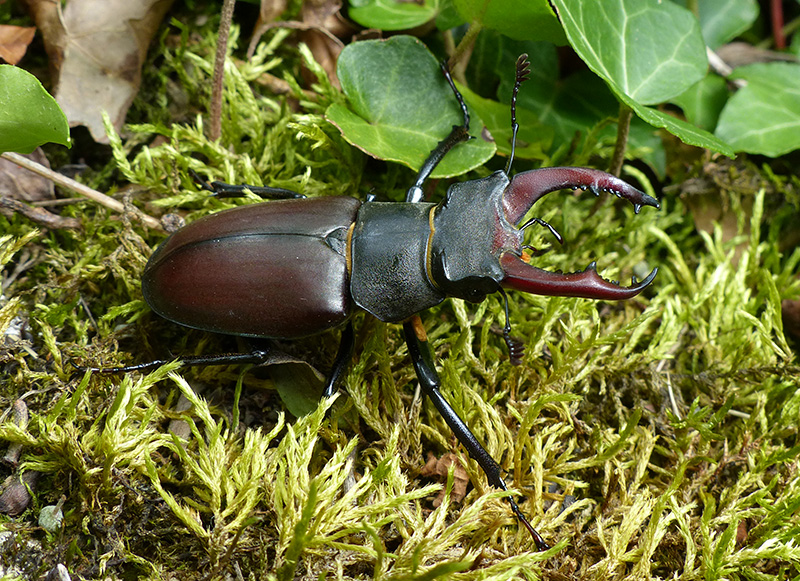
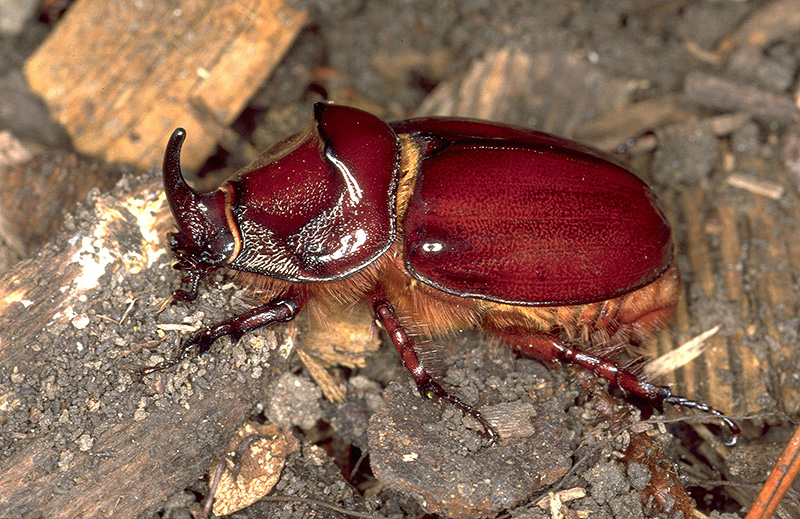
Fig. 5 - Two of central Europe’s biggest and most beautiful beetles, the stag beetle and the rhinoceros beetles have become very rare in Switzerland. Their larvae develop in mulm. Photos: Thomas Reich, Beat Wermelinger (WSL)
Encouragement of deadwood
Primeval forests contained around 50 to 200 cubic metres of deadwood per hectare. According to the latest Swiss National Forest Inventory from 1999 there are now, on average, 12,5 cubic meters of deadwood in the Swiss forests, in the Alps at least 20 cubic metres. Common opinion often prevails that deadwood has to be cleared out of the forests for aesthetic reasons and for its protection. The general public however is slowly becoming aware of the function and importance of deadwood. After the storms Vivian (1990) and Lothar (1999) more deadwood was left laying around because it was no longer profitable and forest workers could not cope with the amount.
Studies by the Swiss Federal Institute WSL into areas affected by the storm Vivian in 1990 show that the number of species of all insects – not just dead wood inhabitants- in areas which had not been cleared was definitely more of less the same as in cleared areas. The difference was in the composition of the species. The trial areas which had not been cleared of wood from the storm, therefore providing a much larger supply of deadwood, showed a higher number of longhorn beetles and jewel beetles compared to cleared areas. The storm areas also showed a much higher number of species than in an intact forest. From the point of view of insect variety it would therefore be worthwhile after a storm, on the one hand, clearing some areas (where the yield is greatest) and on the other hand, leaving other areas uncleared.
High root stumps which have been left standing provide an important substrate for saproxylics. In mountain forests these also help protect against rock fall and avalanches. Care does however have to be taken with freshly felled spruce trees because of the danger of mass reproduction in spruce bark beetles. It must be stressed however that these bark beetles do not usually develop in dead wood older than one year. It can generally be said that beetles which colonise trees which have been dead for a while are not a danger to trees still living.
Sustainable wood production and the promotion of deadwood do not rule each other out. Whilst the best most easily accessible trunks could be used, trees of lesser quality or old, damaged, dead or fallen trees could be left standing or laying where they are. To increase the variety of saproxylics as many different structures as possible should be made available, such as thickness, age, species of wood (also softwood) in varying stages of decomposition and with various degrees of sunlight. Good sunlight is very important for many longhorn and jewel beetles. Apart from deadwood for the development of the larvae many beetles are dependent on flower pollen for food and the necessary flowers are mainly to be found in sparse forests and on forest edges. These structures and substrates should be available continually and at the same time evenly distributed. An attractive forest does not necessarily have to be cleaned up and even a healthy forest needs some dead and ill trees.
Translation: Dawn Meister, Stallikon

